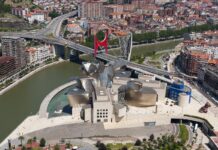This article was translated by John R. Bopp
We’d been holding onto this article by Ike Ijeh for the magazine Building, a British magazine about the world of construction that’s been published since 1843. It’s about the “Bilbao effect”, and at first, we didn’t want to publish it, because we’ve already written so much about it.
Nevertheless, we felt we really had to, especially because we see that simplistic and empty ideas have an incredible way of settling in and becoming the reference points from which others base more articles, without ever digging too deep.
It’s tiring, to say that least, that even now, we’re still coming across statements like this, which started the article off:
It’s called the Bilbao effect: an impecunious city engages a stellar architect to build an arts venue at fabulous expense in the expectation that urban regeneration will follow as night follows day…
Bilbao was never a “poor” city. It’s true, like many cities around the world, economic changes certainly affected the city, and not always for the better, but one couldn’t say the city was ever poor.
Moreover, defining the cost of the Guggenheim as some “fabulous expense” seems inappropriate from an expert in urban planning. If we set the investment in the museum in the context of other investments made to transform Bilbao, that statement comes across as absurd: of the €7 billion (that’s with 9 zeroes) invested, the Bilbao Guggenheim Museum represents €166 million (including the cost to construct the building, as well as its first permanent collection).
For reference, the revenue agencies of the provinces of the Basque Autonomous Community took in €15 billion (again, 9 zeroes) (from a population of 2.3 million people).
So, yes, one needs to choose one’s effusive adjectives more carefully. And while it’s true that other cities have also jumped into large cultural infrastructure projects with the idea of sparking a miracle, this is not the fault of what happened in Bilbao. It’s the fault of not asking the Basque institutions that got this going what their goals were and how they went about doing it. There’s also some blame to lay at the feet of those who write with inadequate knowledge, based on preconceptions that can’t withstand a good, hard, common-sense look.
To provide some perspective, and show would-be “Bilbao effect” article writers how it’s done, we’d like to offer you the blog entries by urban planner Richard Layman, published in the blog Rebuilding Place in the Urban Space. There’s a thorough analysis and explanation for you
Building – 5/12/2018 – Great Britain
Cities love to build arts venues to trigger urban regeneration – but it doesn’t always work out
It’s called the Bilbao effect: an impecunious city engages a stellar architect to build an arts venue at fabulous expense in the expectation that urban regeneration will follow as night follows day. Alas, it doesn’t always turn out this way. Ike Ijeh gets his shotgun out
(Follow) (Automatic translation)
Last Updated on Dec 20, 2020 by About Basque Country
































